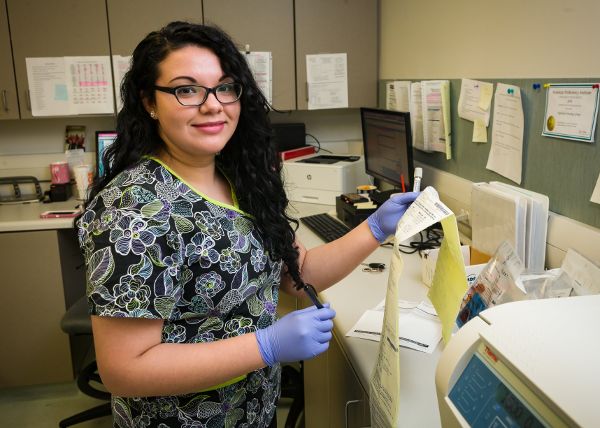Overview
Ovarian cancer begins when cells in the ovaries or fallopian tubes start to grow uncontrollably. A tumor can form when more cancer cells develop, and it can spread to other areas of the body. As it grows and spreads, the cancer becomes more advanced.
The ovaries are female reproductive glands located on either side of the uterus. They produce the ova (eggs), which move to the uterus via the fallopian tubes and are fertilized during the reproductive process, and the female hormones responsible for regulating the menstrual cycle and other processes of the reproductive system.
Some abnormal growths in the ovaries are not cancerous (benign), or have a low potential to spread (borderline or low malignant potential).
Types of ovarian tumors include:
- Epithelial ovarian tumors
- Benign epithelial ovarian tumors
- Borderline epithelial ovarian tumors
- Malignant epithelial ovarian tumors
- Serous carcinomas
- Clear cell carcinomas
- Mucinous carcinomas
- Endometrioid carcinomas
- Ovarian germ cell tumors
- Ovarian stromal tumors
- Ovarian cysts
Symptoms
It is important to note that the symptoms below can be caused by a number of other non-cancerous causes, and many occur just as frequently in women without ovarian cancer, but it is important to be checked by a medical professional with these symptoms. When these symptoms are caused by ovarian cancer, they usually occur persistently and are abnormal for the patient (more severe, more frequent, etc.).
Most common symptoms of ovarian cancer may include:
- Bloating
- Abdominal or pelvic pain
- Trouble eating, or feeling full quickly
- Urinary urgency or frequency
Other symptoms may include fatigue, upset stomach, back pain, pain during intercourse, constipation, changes in the menstrual cycle (heavier bleeding, irregular bleeding, etc.), or abdominal swelling with weight loss.
Risk Factors
Older women are at a higher risk of developing ovarian cancer. Most cases develop after menopause, and half are found in women 63 or older.
Ovarian cancer risk for women with a mother, sister, or daughter who has a history of ovarian cancer is increased, and is even higher for those with multiple relatives affected by the disease. A personal history of breast cancer may also increase a woman’s risk of developing ovarian cancer, thought to be due in part to shared reproductive-system and genetic risk factors.
Estrogen (hormone replacement) therapy after menopause, especially for at least five years, increases ovarian cancer risk, but this increase may not be as significant if progesterone is administered during the same course of treatment (which is known as combination hormone therapy).
Women who have never had a full-term pregnancy or have done so only after the age of 35 are at a higher risk of developing ovarian cancer. Ovarian cancer risk decreases for every full-term pregnancy, and breastfeeding may lower risk even further. Fertility treatments (IVF) may increase the risk of borderline tumors, but research has not demonstrated a link between fertility treatments and more invasive types of ovarian cancer.
Certain methods of birth control may lower the risk of ovarian cancer. Oral contraceptives lower risk significantly, drive risk lower the longer they are used, and protect against ovarian cancer for many years after they are discontinued. Tubal ligation and the intrauterine devices (IUDs) also seem to reduce risk. Hysterectomy may reduce risk by as much as one-third.
Some gene mutations may increase the risk of ovarian cancer, including the BRCA1 or BRCA2 genes (also associated with a higher risk of breast cancer). For more information about genetic risk factors, visit the American Cancer Society website or discuss genetic counseling with your doctor.
Prevention
Most known modifiable risk factors only slightly increase a woman’s risk of developing ovarian cancer, so it is not possible to prevent most cases. Of these modifiable factors, most involve major medical interventions or decisions, and should be discussed with your doctor to determine alternative options and risks:
- Maintain a healthy weight.
- Avoid estrogen therapy. If hormone replacement therapy is indicated for you, discuss your options and risks thoroughly with your doctor.
- Use oral contraceptives. Discuss benefits and risks with your doctor.
- Consider surgical interventions as medically appropriate: tubal ligation, hysterectomy, bilateral salpingo-oophorectomy (ovary and fallopian tube removal), or bilateral salpingectomy (fallopian tube removal). These operations may reduce ovarian cancer risk but are generally recommended for other medical reasons. However, ovarian cancer risk factors (especially age and family history) should be considered when discussing and choosing what surgery may be right for your case.
- For those at high risk of ovarian cancer due to family history, consider genetic counseling and discuss the prevention strategies above.
Diagnosis
Early detection of ovarian cancer is associated with very positive outcomes in treatment, so it is important to receive regular women’s health exams, report symptoms, and discuss risk factors and the possibility of screening with your doctor. Currently available screening tests include transvaginal ultrasound and the CA-125 blood test, but these are not considered reliable enough to recommend to women at average risk for ovarian cancer. Other screening methods are being actively researched.
If there is a suspicion of ovarian cancer, you should be examined by a doctor. A detailed medical history and physical exam will be performed. Your doctor will ask questions about your risk factors and family history. The physical exam will include a pelvic exam.
Consultation with a gynecologic oncologist and imaging tests including ultrasound, CT, x-ray, MRI, and PET will help diagnose and determine the course of treatment for an ovarian tumor.
A surgical biopsy is often used to confirm the diagnosis of other types of cancer, but in suspected cases of ovarian cancer, doctors will usually recommend complete removal of the tumor rather than biopsy. In rare cases, biopsy may be recommended instead.
Other tests may be used in addition to the diagnostic tools discussed above. These may include blood tests, scoping procedures, and genetic testing.
Treatment
The treatment plan will depend on the stage of the cancer, as well as other factors. Our doctors will work closely with you and your family determine the best treatment plan for you. Options for treatment could include:
- Surgery
- Radiation therapy
- Chemotherapy
- Hormone therapy
- Targeted therapy
Your doctor may decide more than one of these treatment options will be in your best interest. Treatment commonly includes surgery and often combines multiple therapies.







